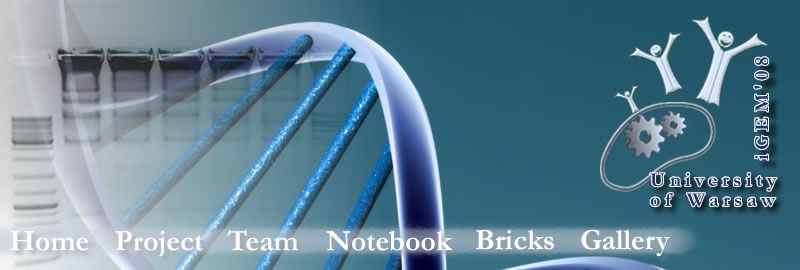Team:Warsaw/Calendar-Main/16 May 2008
From 2008.igem.org
(Difference between revisions)
(New page: {{WarNotebook}} <!-- do not edit above me! --> 1. PCR - AID for translation fusion Primers: AIDlNrH AIDpLinB Template DNA: pTrc99A-AID Annealing temperature: 55 °C Annealing time: 6...) |
MKrzyszton (Talk | contribs) |
||
| (39 intermediate revisions not shown) | |||
| Line 1: | Line 1: | ||
{{WarNotebook}} | {{WarNotebook}} | ||
<!-- do not edit above me! --> | <!-- do not edit above me! --> | ||
| + | <html><h3>Preparation of <a href=https://2008.igem.org/Wiki/Team:Warsaw/vectors/pMPM-T5%2BAID%2BT7>pMPMT5-AID+T7</a> and <a href=https://2008.igem.org/Wiki/Team:Warsaw/vectors/pMPM-T5%2BAIDT7>pMPMT5+AID-T7</a></h3> | ||
| + | <h4>Michał K.</h4> | ||
| + | <p> | ||
| + | <ol><li>Gel electrophoresis (<a href="https://2008.igem.org/Team:Warsaw/Calendar-Main/15_May_2008">15 May</a> PCR's) and DNA <a href="https://2008.igem.org/wiki/index.php?title=Wiki/Team:Warsaw/protocols#DNA_isolation_from_agarose_gel">isolation</a> from proper bands (600 bp for AID lane and 2700 bp for T7 polymerase lanes).</li> | ||
| - | + | <li>Electrophoresis to estimate the concentration of isolated DNA.</li> | |
| + | <li> <a href="https://2008.igem.org/wiki/index.php?title=Wiki/Team:Warsaw/protocols#pcr">PCR</a> - <a href=https://2008.igem.org/Wiki/Team:Warsaw/vectors/pMPM-T5%2BAIDT7>translational fusion</a>: AID + T7 RNA-polymerase - optimization (annealing temperature gradient 60°C - 80°C). <a href="https://2008.igem.org/Team:Warsaw/Calendar-Main/16_May_2008#fig1">Fig. 1</a>.<br> | ||
| - | Primers: | + | Primers: <br> |
| - | |||
| - | |||
| - | + | <a href="https://2008.igem.org/Wiki/Team:Warsaw/primers#AIDlNrH">AIDlNrH</a> and | |
| + | <a href="https://2008.igem.org/Wiki/Team:Warsaw/primers#T7pXbSal">T7pXbSal</a> <br> | ||
| - | |||
| - | |||
| - | + | Template DNA: purified PCR products from <a href="https://2008.igem.org/Team:Warsaw/Calendar-Main/15_May_2008">15 May</a> - AID and T7 RNA-polymerase for <a href=https://2008.igem.org/Wiki/Team:Warsaw/vectors/pMPM-T5%2BAIDT7>translational fusion</a> <br> | |
| - | + | Elongation time: 4 minutes <br> | |
| - | Primers: | + | 35 cycles <br> |
| + | </li> | ||
| + | <li> Optimization of <a href="https://2008.igem.org/wiki/index.php?title=Wiki/Team:Warsaw/protocols#pcr">PCR</a> - translational fusion: AID + T7 RNA-polymerase - MgCl<sub>2</sub> concentration and number of cycles. <a href="https://2008.igem.org/Team:Warsaw/Calendar-Main/16_May_2008#fig2">Fig. 2</a>.<br> | ||
| + | Primers: <br> | ||
| - | |||
| - | |||
| - | + | <a href="https://2008.igem.org/Wiki/Team:Warsaw/primers#AIDlNrH">AIDlNrH</a> and | |
| + | <a href="https://2008.igem.org/Wiki/Team:Warsaw/primers#T7pXbSal">T7pXbSal</a><br> | ||
| - | |||
| - | |||
| - | |||
| - | |||
| - | |||
| - | |||
| - | |||
| - | |||
| - | |||
| - | |||
| - | |||
| - | |||
| - | |||
| - | |||
| - | |||
| - | |||
| - | |||
| - | |||
| - | |||
| - | |||
| + | Template DNA: purified PCR products from <a href="https://2008.igem.org/Team:Warsaw/Calendar-Main/15_May_2008">15 May</a> - AID and T7 RNA-polymerase for <a href=https://2008.igem.org/Wiki/Team:Warsaw/vectors/pMPM-T5%2BAIDT7>translational fusion</a> <br> | ||
| + | Annealing temperature: 73°C<br> | ||
| + | Elongation time: 4 minutes <br> | ||
| + | </li> | ||
| + | <li> Gel electrophoresis of PCR products.</li> | ||
| + | </ol></p> | ||
| + | <a name="fig1"><img src="https://static.igem.org/mediawiki/2008/f/f9/Pcr_aid_t7_WAW1.jpg"width=350/></a> | ||
| + | <var><b>Fig. 1.</b> PCR products - optimization of annealing temperature: 1-DNA ladder; <br>2 to 8 -annealing temperature 60°C (in lane 2) to 80°C (in lane 8).</var> | ||
| + | <a name="fig2"><img src="https://static.igem.org/mediawiki/2008/d/d1/Pcr_aid_t7_WAW2.jpg"width=350/></a> | ||
| + | <var><b>Fig. 2.</b> PCR products - optimization of MgCl<sub>2</sub> concentration and number of cycles: <br> | ||
| + | <ol> | ||
| + | <li style="font-family: monospace; margin-left: 3cm"> | ||
| + | DNA ladder; <br> | ||
| + | <li style="font-family: monospace; margin-left: 3cm"> | ||
| + | 2 μl MgCl<sub>2</sub>, 20 cycles; </li> | ||
| + | <li style="font-family: monospace; margin-left: 3cm"> | ||
| + | 3 μl MgCl<sub>2</sub>, 20 cycles; </li> | ||
| + | <li style="font-family: monospace; margin-left: 3cm"> | ||
| + | 2 μl MgCl<sub>2</sub>, 25 cycles; </li> | ||
| + | <li style="font-family: monospace; margin-left: 3cm"> | ||
| + | 3 μl MgCl<sub>2</sub>, 25 cycles; </li> | ||
| + | <li style="font-family: monospace; margin-left: 3cm"> | ||
| + | 2 μl MgCl<sub>2</sub>, 30 cycles; </li> | ||
| + | <li style="font-family: monospace; margin-left: 3cm"> | ||
| + | 3 μl MgCl<sub>2</sub>, 30 cycles; </li> | ||
| + | <li style="font-family: monospace; margin-left: 3cm"> | ||
| + | 2 μl MgCl<sub>2</sub>, 35 cycles; </li> | ||
| + | <li style="font-family: monospace; margin-left: 3cm"> | ||
| + | 3 μl MgCl<sub>2</sub>, 35 cycles.</li> | ||
| + | </ol></var> | ||
| + | </html> | ||
<!-- do not remove this! --> | <!-- do not remove this! --> | ||
{{WarNotebookEnd}} | {{WarNotebookEnd}} | ||
Latest revision as of 13:47, 26 October 2008
 |
|||||||||
Preparation of pMPMT5-AID+T7 and pMPMT5+AID-T7Michał K.
 Fig. 1. PCR products - optimization of annealing temperature: 1-DNA ladder;
Fig. 1. PCR products - optimization of annealing temperature: 1-DNA ladder; 2 to 8 -annealing temperature 60°C (in lane 2) to 80°C (in lane 8).  Fig. 2. PCR products - optimization of MgCl2 concentration and number of cycles:
Fig. 2. PCR products - optimization of MgCl2 concentration and number of cycles:
|
 "
"





